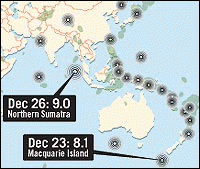THE STRAITS TIMES, Singapore -- REVIEW
Thursday, Jan 20, 2005
AHEAD IN ASIA
Sound the alarm, more quakes are dueBy Anthony PaulWE CANNOT know for sure what other parts of our region can expect major earthquakes over the next few years. Earthquake forecasting is still far from being an exact science.
But the success of one California-based research group, the Centre for Computational Science and Engineering at the University of California, Davis, which pinpointed the Aceh earthquake, is attracting a lot of attention for its new methodology.
And for some parts of Asia - especially Thailand, Myanmar, Taiwan and the adjacent China coast, and Japan - the forecasts over the next five years are not good.
The UC Davis centre's director, Professor John Rundle, told The Straits Times that the group's technique was based on the theory that small earthquakes (of around magnitude 5) were often reliable harbingers of larger quakes (magnitude 7 or greater).
For a world map of the likely locations of great earthquakes for the 2000-2010 decade, the centre's researchers took quake activity data from 1965-2000, then subtracted the 1965-1990 data. Because statistics from so many countries are not always strictly comparable, the centre 'normalises' them (calculates an equivalent standard for all).
The indices thus obtained appear on a map in varying intensities. The Pacific Rim's ominous reputation for quakes of magnitude 7 or more is immediately visible.
Prof Rundle cautioned that the results are not predictions, but rather forecasts. That is, given the prevailing conditions in a particular locality, this is what might happen.
Still, the centre's recent forecasting record is impressive: Of 38 large earthquakes worldwide since 2000, 30 have occurred directly on or within the margin of error of hotspots located on its map.
The magnitude 9 northern Sumatra earthquake was one such hotspot. Another was an undersea rupture at Macquarie Island between Australia and Antarctica three days before the Aceh quake, a disturbance that some seismologists believe may have triggered the Dec 26 catastrophe.
Said Prof Rundle: 'These results indicate that the technique developed by our group can successfully identify the locations for 80 to 90 per cent of future large earthquakes over time periods of up to a decade or so.'
Earlier this year, a forecast for California successfully predicted the locations of 12 of 14 earthquakes of magnitude 5 or more since Jan 1, 2000.
One of the centre's most impressive Asian performances came in 2003, in Japan. In a lecture at Kyoto University on Oct 13, UC Davis researcher Kazuyoshi Nanjo forecast that an earthquake would take place in Niigata province on a previously unknown fault. Just 10 days later, a series of earthquakes did occur there, killing 40 people and injuring up to 2,860.
As always, Japan's position on several fault planes makes it highly susceptible to earthquakes: Nearly 10 per cent of the energy released in the world yearly by earthquakes is concentrated in and around its islands. Its long coastline, which is open to the north Pacific, also leaves the country vulnerable to tsunamis.
Exactly 305 years ago next Wednesday a massive earthquake in the so-called Cascadia Subduction Zone running from Cape Mendocino in California to Canada's Vancouver Island set off a massive wave that swept across the Pacific. An 18th-century Japanese diarist recorded the precise moment it hit: 9pm, Jan 26, 1700.
The 1,000km long Cascadia Zone and another in Alaska are attracting seismologists' attention. The reason: Like Sumatra, they are places where one of the earth's great subterranean plates is being subducted - one forced underneath another.
Off California, the Pacific Ocean plate is diving under the North American continent. Off Aceh, the India plate was being forced beneath the Myanmar microplate. A rupture throughout a fault as long as the Cascadia Zone created the tsunami.
What do Prof Rundle's researchers say about Asia's earthquake future?
The seismologist told The Straits Times that the centre's method 'does not provide priority lists'. However, Asia will not lack major seismic activity over the next five years.
He warned: 'I'd say Taiwan and adjacent China coast, Japan - especially the northern half of Honshu, the main island - and the sea-bed off Myanmar-Thailand coast could expect earthquakes of magnitude 7 or more.'
The hotspot west of Myanmar-Thailand is adjacent to the Sumatra fault zone 'and the Aceh earthquake is likely to have loaded that one up substantially,' he said.
'Those folks (Myanmar and Thailand) should get a tsunami warning system in place there fairly quickly - if they haven't done so already.'
To its credit, the Thai government is not waiting. Within four days of the Aceh tsunami, Prime Minister Thaksin Shinawatra had given the problem to former chief weather forecaster Smith Tumsaroch.
Since a tsunami disaster in Papua New Guinea in 1993, Mr Smith had been warning of the danger of killer waves hitting Thailand. No one listened then, and some even called him an eccentric alarmist.
But now he has Thailand's attention. He is back from retirement - as a vice-minister charged with building a US$30 million (S$49 million) Andaman Sea duplicate of the US Tsunami Warning Centre in Honolulu.
Before the end of this year, said Mr Smith, 'news trumpeting towers' will be built along coastlines and on islands to warn of tidal waves in the Andaman Sea. Sirens audible within a 1km radius will warn the populace to hurry inland.
